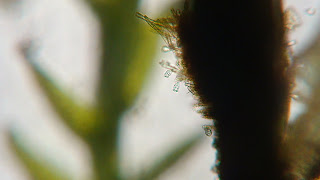(10/14/09)
I choose to do #10 on Lynnhurst Cemetery. I am curious what kind of microbes look like in the water and what it does. The water source is from Lynnhurst Cemetery's, located at Adair Drive, Knoxville, Tn. The water pool below spring is contaminated from run-off water from the cemetery. The muck from the water pool, 2/3 full surface water, and two other kind of mosses in the pocket of glass tank to be observed through the objective lens in low and medium power. There are various immobile and mobile organisms were identified during the lab: Cyanobacteria, Chlamydomonas, Euglena, Cyclops, and Spirogyra. There are so many of them I have not able to identified yet. Some organisms move in circular movement, some zigzag, many different of sizes, some remain stationary, others move really quick, and others move fro and back slowly. I created an image what I saw and some of organisms are strange to me.
Image created by Jo:


Desmids like Xanthidium? It looks like a star or spiky shape, bright as yellow/light green, stationary. (top left of the image and picture at the right)

Spirogyra: eukaryote, long filamentous algae, green, comes from pond scum (muck), cell shapes like helix. Picture shown at right.
Cyclops: animalia, large body than other microbe fresh-water organism, brown/black, two flagella, and a tail. It moves pretty fast. (right bottom of the image)
Cyanobacteria: bacteria, blue-green, shapes like stick, stationary.
Euglena: unicellular protists, red at tip, elongated stick, green body. Moves slow.
Unidentified fresh-water organisms:
1) yellow, moves slowly, moves fro and back, long circular body.
2) body shrinks and then swells, repetition, as it moves forward, elongated slowly. (left bottom of the image)
3) circular shape, circular movement, yellow/green. Slow. (center of the image - black with several tails)
4) Fast movement, many tiny, light green organisms move in zigzag in all direction. (right top of the image - black circle)
References:
Two photograph images are copyright by Wim van Egmond, 1998.


 Fig. 3
Fig. 3



 Fig. 5: The mystery finally revealed
Fig. 5: The mystery finally revealed











